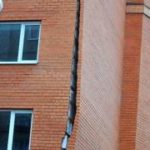How to perform floor insulation with your own hands properly.
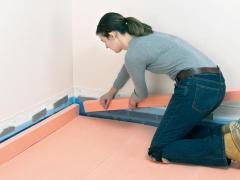 Floor insulation is one of the most important construction processes you need to perform to reduce heat loss in your house. Moreover, a fundamental factor is the temperature of the floor surface. The way to reduce heat loss usually includes several components. One of them is the thermal insulation of the floor. Heat loss in poor insulation not only reduces the level of comfort of your living space, but also increases the waste of space heating. No matter what floor is in your house – concrete or wood – it should be warm.
Floor insulation is one of the most important construction processes you need to perform to reduce heat loss in your house. Moreover, a fundamental factor is the temperature of the floor surface. The way to reduce heat loss usually includes several components. One of them is the thermal insulation of the floor. Heat loss in poor insulation not only reduces the level of comfort of your living space, but also increases the waste of space heating. No matter what floor is in your house – concrete or wood – it should be warm.
Before performing the floor insulation is necessary to choose the right variant of insulation. The main criteria dealing with heat-insulating materials are:
- lightweight;
- poor thermal conductivity;
- moisture;
- durability.
Insulation is usually chosen depending on the device of the floor, the type of flooring and destination areas. The most popular insulation 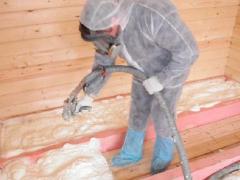 materials are:
materials are:
- foam;
- mineral wool;
- polyurethane foam;
- Styrofoam;
- expanded clay;
- perlite.
Concrete floor insulation
Depending on the device of the floor, the insulation of concrete floor is traditionally made on logs or on concrete. In the first case you can use bulk insulation or mineral wool. Since the logs take the main weight of the floor, the load on the material will be insignificant. Dealing with floor insulation on concrete base the main burden will be transferred to the insulating layer. In this case it is better to use extruded polystyrene or mineral boards.
Thermal insulation of the floor joists
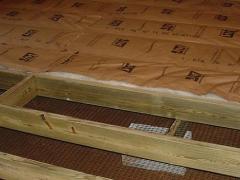 The thermal insulation on logs is usually performed during the construction process. While using this method the ceiling height is reduced to the height of the floor (3-4 inches). The concrete base should be perfectly dried before laying insulation. Put a layer of waterproofing material or plastic film over it. Next, set the log increments of about 2 feet. Then lay the insulation material into the space between the joists. The thickness of the insulating material must be 1 inch lower than the height of the log. It is necessary to provide the air circulating under the floor. The next step is equipping the raised floor (during the installation step away about 15mm from each wall). For this purpose use chipboard or waterproof plywood.
The thermal insulation on logs is usually performed during the construction process. While using this method the ceiling height is reduced to the height of the floor (3-4 inches). The concrete base should be perfectly dried before laying insulation. Put a layer of waterproofing material or plastic film over it. Next, set the log increments of about 2 feet. Then lay the insulation material into the space between the joists. The thickness of the insulating material must be 1 inch lower than the height of the log. It is necessary to provide the air circulating under the floor. The next step is equipping the raised floor (during the installation step away about 15mm from each wall). For this purpose use chipboard or waterproof plywood.
Working with chipboard
Before the installation of the insulation material you should dry the concrete floor covered with waterproofing material. Begin laying the tiles, stepping away from each wall about 15mm. If you don’t, the influence of heat and moisture stove will expand and deform the tiles. Fixing of the insulating material is performed with the help of dowels. When all the piles are stacked, docking slot are pasted with grid construction. Then they are obscured with putty diluted with oil paint. On the top of the heat insulating layer the flooring is planked.
The “floating floor” method
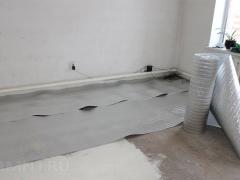 The method of the “floating floor” was named so because of the lack of communication with a concrete floor screed. First the insulation layer is laid. This may be glassine. Laying it must be performed overlapped (one lane to another with an overlap width of about 4 inches). At the joints between the floor and the wall a little bit of glassine must go to the wall. The next layer is the insulation made of mineral wool, foam or extruded polystyrene. Laying insulation material should be performed close to each other.
The method of the “floating floor” was named so because of the lack of communication with a concrete floor screed. First the insulation layer is laid. This may be glassine. Laying it must be performed overlapped (one lane to another with an overlap width of about 4 inches). At the joints between the floor and the wall a little bit of glassine must go to the wall. The next layer is the insulation made of mineral wool, foam or extruded polystyrene. Laying insulation material should be performed close to each other.
Attention! The slightest gap between the layers of the different materials is the mistake!
It is better to lay two thin layers in opposite directions than to lay one thick layer. By means of guide rails the entire structure is filled with concrete mix. After hardening of the concrete, the rails are removed, grooves remaining after them are then filled with a solution. When you fill your “floating floor” it is necessary to ensure that the concrete didn’t get to the wall and the screed. Otherwise the floor will not be the “floating” one. After the drying of the floor you should carefully check it for defects – if they are, they have to be eliminated immediately for your work not to be done in vain
Thermal insulation of the concrete floor with the thermal carpet
Before laying the thermal carpet or linoleum to the insulation materials, you need to prepare the base. First you should align the concrete floor. It is desirable to lay the polyurethane foam on the top. The thermal carpet or linoleum can be glued to the base using any construction glue of high quality or be fixed by baseboards. The places of docking of the flooring are traditionally glued. To make your floor even more warmer, put an extra layer of felt insulation under the thermal carpet.
Izolon insulation
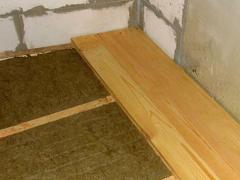 Izolon has many advantages required for the most of heat-insulating material. In addition to its good insulating characteristics it is:
Izolon has many advantages required for the most of heat-insulating material. In addition to its good insulating characteristics it is:
- lightweight,
- flexible,
- resilient.
Moreover, izolon has almost zero water absorption and very high resistance to decay. This method is good for those who think that the floor insulation with your own hands is a very daunting task that needs to be performed nevertheless. The method of its installation is quite simple. Izolon is rolled out on the floor, then it is bonded to the base tape. The ready-made self-adhesive izolon is sold coated with adhesive on its one side.
Working with the technical cork
Despite the fact that the thickness of the technical stoppers is less than 10mm, it is still able to retain heat for a long time. The small thickness of the product allows you to insulate floors – even in two layers – without concealing the height of the room. The method for laying a technical stopper is the same as for izolon. The main advantage of this material is its environmental friendliness, the main disadvantages is that it’s quite pricey.
Wood floor insulation
For wooden houses it’s best to choose environmentally friendly materials, because it may be very important for the house owner to maintain an aura of perfect natural components. Therefore, floor insulation in a wooden house HAS TO be made of environmentally friendly materials. The presence of insulation phenol, ethanol and other non-natural components has to be scanty. Use mineral wool or fiberglass. Choosing the material you should take into account that it should be of light shades.
Important! Brown group of mineral wool materials indicates the presence of phenol-formaldehyde resins in them!
The presence of the additives in the fiberglass gives materials a yellowish hue. Anyway, while choosing the material it is desirable to get acquainted with the structure of the floor.
 The thermal insulation of wooden floors is similar to the insulation of concrete floors on logs, but has some nuances:
The thermal insulation of wooden floors is similar to the insulation of concrete floors on logs, but has some nuances:
- the insulating material is laid over the subfloor;
- between the insulation material and the floor the airspace should be left;
- the distance from the heater to the subfloor should be of about 10-12mm, and the distance to the finished floor is up to 15mm;
- airspaces not only improve the thermal insulation of the floor, but also provide removal of the excess moisture.
Moisture is known to lead to rotting. The only drawback of this insulation method is the possibility of settlement of rodents in the airgaps. To avoid this you should make an obstacle in the form of fine-mesh metal grid under the subfloor.
We hope this article helped you to answer the question how to install floor insulation with your own hands.
